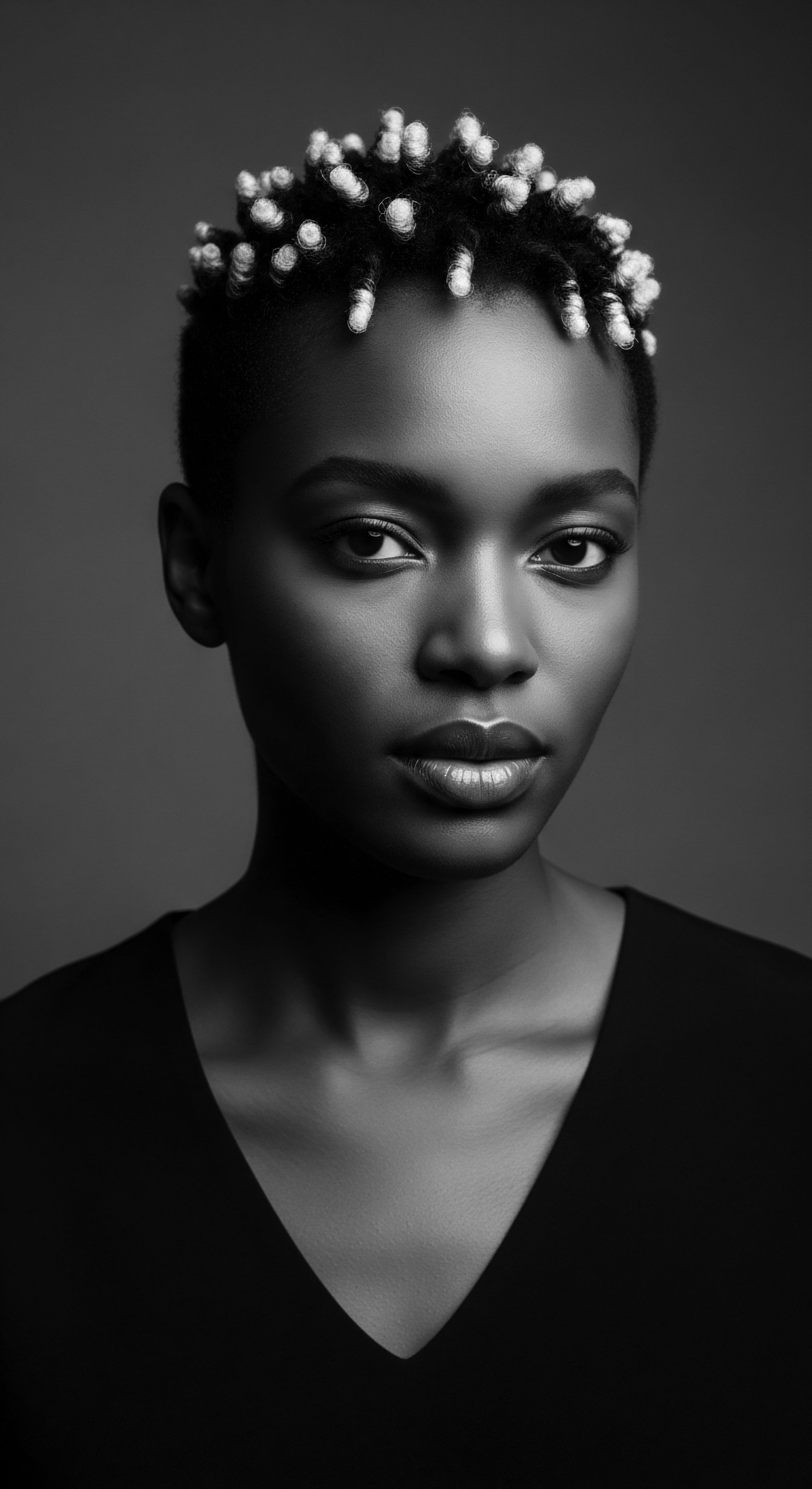
Fundamentals
The concept of Care Rituals, particularly when contemplating the profound legacy of textured hair, unfurls not as a mere sequence of steps for maintenance but as a living declaration. This is a practice reaching into the very core of being, resonating with ancestral knowledge and the elemental forces of nature. For generations, people with textured hair have understood intuitively that hair care extends beyond simple hygiene. It is a dialogue with one’s body, a communion with inherited wisdom, and a deliberate act of reverence.
At its simplest, a Care Ritual describes any patterned engagement with one’s hair that carries intent beyond basic cleaning. This involves a conscious decision to nourish, protect, and adorn the hair, often employing specific tools, ingredients, and techniques. The definition of a ritual implies regularity and a deeper meaning ascribed to the actions. For textured hair, this significance is amplified by centuries of cultural expression, resistance, and identity formation.
Care Rituals transcend mere hair maintenance, embodying a profound connection to ancestral legacy and personal identity for those with textured hair.

Hair as Identity’s First Whisper
From the earliest records, hair has stood as a powerful visual language, a tangible connection to social standing, spiritual beliefs, and communal belonging. Across countless African societies, intricate styles and meticulous care practices marked life’s passages ❉ birth, initiation, marriage, and mourning. The attention given to hair was never frivolous; it conveyed narratives about an individual’s lineage, their role within the collective, and their relationship with the unseen world. The historical significance of hair, therefore, provides a foundational understanding for the true meaning of Care Rituals.
Understanding Care Rituals begins with recognizing hair not merely as a biological appendage, but as a living extension of self. For many, particularly within Black and mixed-race communities, hair has endured as a persistent symbol of resilience amidst adversity, a canvas for storytelling, and a cherished link to heritage. The care given to hair, then, becomes a vehicle for expressing self-worth and honoring a rich cultural inheritance.

Elemental Touchstones of Care
The basic elements constituting Care Rituals typically encompass cleansing, conditioning, moisturizing, styling, and protecting the hair. Yet, within the context of textured hair, each of these actions often assumes a more deliberate, time-honored character.
- Cleansing ❉ Beyond removing impurities, this act historically served as a spiritual purification, often using natural elements like clays or plant-based infusions.
- Conditioning ❉ The application of restorative agents, frequently derived from local botanicals, aimed to imbue the hair with strength and vitality, maintaining its intrinsic structure.
- Moisturizing ❉ This essential practice, crucial for textured hair’s propensity for dryness, involved rich oils and butters, providing a protective barrier against environmental challenges.
- Styling ❉ Adornment and manipulation into braids, twists, or coils formed powerful statements of identity, status, and artistry, often requiring communal effort.
- Protecting ❉ Practices such as covering hair at night or using protective styles guarded strands from breakage and environmental stress, preserving their length and health.
These elementary components, repeated with intention, form the bedrock of Care Rituals, offering a glimpse into a timeless interplay between biological need and cultural expression. The early application of these simple principles laid the groundwork for sophisticated systems of hair stewardship that would persist through epochs.

Intermediate
Stepping beyond the fundamental mechanics, an intermediate appreciation of Care Rituals reveals their deeply intertwined nature with holistic well-being and community life. The meaning of these practices expands, reflecting not just physical maintenance, but profound psychological, social, and spiritual dimensions. This level of understanding acknowledges that the hands that tended hair often simultaneously imparted wisdom, solace, and a sense of belonging. The very act of hair care frequently provided a space for intimate bonding and the sharing of generational narratives.

Beyond Physical Sustenance ❉ The Holistic Thread
Care Rituals for textured hair, historically and presently, speak to a broader understanding of health. The health of the hair itself was seen as an outward manifestation of inner balance, a reflection of one’s vitality and connection to the earth’s rhythms. The selection of natural ingredients – often plants, oils, and minerals specific to a region – affirmed this connection, aligning the body with its ecological context. These were not mere cosmetic products but often had medicinal properties, supporting scalp health and stimulating growth.
Traditional care practices were typically unhurried, demanding patience and presence. This intentional slowing down created an opportunity for introspection, a meditative space where stress could dissipate and a sense of calm could settle. For many, these moments became a form of self-affirmation, a quiet rebellion against external pressures that sought to diminish or devalue natural hair.

Community’s Embrace ❉ The Tender Weave
The communal aspect of Care Rituals holds immense significance. In many traditional societies, hair styling was a collective endeavor, a social occasion where stories were shared, laughter echoed, and intergenerational bonds were fortified. Children learned the ways of their elders through observation and participation, absorbing not only the techniques but also the cultural stories and values embedded within each stroke of the comb or twist of a braid.
This communal engagement fostered a powerful sense of unity. Hair salons in diasporic communities, for instance, became more than commercial establishments; they transformed into vital social hubs, repositories of oral histories, and spaces for collective healing and joy. The shared experience of hair care created a unique language of intimacy and understanding.
| Traditional Practice Context Group hair dressing sessions in pre-colonial West Africa, where elders shared stories and advice. |
| Contemporary Relevance (Diaspora) Black hair salons serving as community centers for social networking, mentorship, and cultural exchange. |
| Traditional Practice Context Mothers teaching daughters intricate braiding patterns, reinforcing familial bonds and cultural identity. |
| Contemporary Relevance (Diaspora) Parents learning protective styling techniques from online communities, connecting with a global network of textured hair caregivers. |
| Traditional Practice Context Preparation of communal hair care ingredients (e.g. shea butter, red palm oil) for shared use within a village. |
| Contemporary Relevance (Diaspora) Cooperative ventures or community-supported agriculture initiatives focusing on ethically sourced, traditional ingredients for hair products. |
| Traditional Practice Context The enduring legacy of shared care practices underscores the inherent social nature of textured hair rituals across time. |

The Spiritual Resonance of the Strand
A deeper look at Care Rituals reveals their spiritual undertones. Hair, often considered the closest part of the body to the heavens, served as a conduit for spiritual energy and communication. Certain styles were worn for protection, others for prayer, and some to signify spiritual devotion.
The act of washing and anointing hair could be a form of ritual purification or an invocation of blessings. This spiritual connection underscores the sacredness often associated with hair, making its care a deeply personal and reverent act.
The deliberate engagement with hair, often involving quiet contemplation or the recitation of affirmations, transforms mundane maintenance into a sacred rite. This practice honors the body as a temple and acknowledges hair as a unique expression of the divine within. This perspective helps us grasp the pervasive influence of ancestral reverence within the enduring heritage of Care Rituals.

Academic
The academic definition of Care Rituals, specifically within the rich context of textured hair, extends into the intersection of anthropology, sociology, biological science, and cultural studies. Here, it signifies a complex interplay of volitional actions, cultural prescriptions, and embodied knowledge systems, meticulously executed for the maintenance, enhancement, and symbolic expression of hair. This understanding acknowledges hair as a dynamic bio-cultural artifact, its manipulation deeply inscribed with historical agency, communal identity, and individual psychological well-being. Care Rituals, at this level, are understood as highly structured, often intergenerational practices that transmit cultural norms, aesthetic values, and practical skills, all while serving as a consistent affirmation against historical forces of oppression and aesthetic marginalization.

Etymological Roots and Theoretical Frameworks
The term ‘ritual’ itself, originating from the Latin rituale (meaning “concerning a rite”), implies a formalized sequence of actions, often imbued with symbolic significance and performed within a specific cultural or religious context. Applied to hair care, this framework moves beyond mere routine to describe deliberate, intentional acts that often carry social or spiritual weight. From an anthropological lens, Care Rituals in the context of textured hair can be viewed through the framework of Victor Turner’s theories on performance and liminality, where the act of hair care becomes a transformative experience, a space for identity negotiation and communal reaffirmation. The preparation and styling of hair, particularly for significant life events, often involve a liminal period where individuals transition between social states, marked by the meticulous attention to their crowning glory.
A key theoretical perspective also draws from Pierre Bourdieu’s concept of habitus, where Care Rituals are seen as embodied dispositions that are both individually practiced and collectively shaped. These practices become naturalized behaviors, passed down through generations, often without explicit instruction, but through observation, imitation, and shared experience. The very texture of Black and mixed-race hair, with its inherent diversity and unique structural demands, necessitated adaptive, sophisticated care methods that became codified as rituals, evolving in response to both environmental factors and socio-political landscapes.
Care Rituals for textured hair are not simply routines; they are codified knowledge systems, embodying cultural resistance and the transmission of identity across generations.

Socio-Cultural Anthropology of Hair and Resistance
From an anthropological perspective, Care Rituals illuminate the profound connection between human practices and cultural meaning, particularly within diasporic communities. Hair, as a visible and malleable aspect of the self, has historically served as a potent site for cultural expression, political resistance, and the assertion of identity. The meticulous care of textured hair, often viewed with disdain by dominant Eurocentric beauty standards, became an act of subversive affirmation, a defiant embrace of ancestral aesthetics.
A compelling illustration of this profound connection to textured hair heritage and ancestral practices is found in the elaborate hair care rituals of the Mbalantu Women of Namibia. The Mbalantu, a sub-group of the Ovambo people, practice a multi-year, multi-stage hair growth and styling ritual known as ekori. This practice, central to their cultural identity and a marker of passage into womanhood, involves an intricate process of growing extremely long hair, often reaching floor-length, by continuously incorporating false hair fibers and a mixture of pounded tree bark, fat, and traditional herbs (van der Westhuizen, 2011). The Care Rituals for these women are not a weekly wash-day; they are a continuous, living testament to cultural endurance.
The ekori style requires daily application of nourishing mixtures and meticulous restyling, often performed by older female relatives, cementing intergenerational bonds and transmitting specialized knowledge. This is a practice where the physical act of caring for hair intertwines inextricably with social status, spiritual well-being, and the collective memory of a people, serving as a powerful, non-verbal communication of identity. It stands as a vivid example of Care Rituals as a sustained cultural performance, rather than merely functional grooming.
The deliberate preservation of such labor-intensive practices, even in the face of modern alternatives, speaks volumes about their enduring cultural resonance. These rituals serve as a pedagogical tool, teaching younger generations patience, artistry, and an appreciation for their unique heritage. The time invested in these Care Rituals translates into a tangible manifestation of cultural pride and continuity, defying external pressures to conform.

Biomechanical and Physiological Underpinnings
A scientific understanding of Care Rituals acknowledges the unique biomechanical and physiological characteristics of textured hair. The helical structure of curly and coily strands, the elliptical shape of the follicle, and the distribution of disulfide bonds contribute to specific needs concerning moisture retention, fragility, and susceptibility to breakage. Care Rituals, then, are expertly evolved strategies to mitigate these inherent challenges.
The traditional use of occlusive agents such as shea butter ( Butyrospermum parkii ) or coconut oil ( Cocos nucifera ), common in ancestral practices, is now understood through their ability to create a hydrophobic barrier on the hair shaft, reducing transepidermal water loss and preventing hygral fatigue. Similarly, the practice of braiding or twisting, deeply embedded in Care Rituals, mechanically reduces tangling and friction, which are primary causes of breakage in highly textured hair. This scientific validation of long-standing practices underscores the empirical wisdom embedded within ancestral hair care.
- Hair Shaft Structure ❉ The unique, often flattened or elliptical cross-section of textured hair strands, coupled with points of torsion along the helix, necessitates gentle handling and specialized detangling methods.
- Moisture Dynamics ❉ The greater surface area and looser cuticle layers of highly textured hair increase its susceptibility to moisture loss, making consistent application of humectants and emollients fundamental.
- Tensile Strength ❉ The points where the hair shaft bends or coils are intrinsically weaker, rendering textured hair more prone to breakage under stress, thus protective styling becomes a core preventative measure.
- Scalp Microbiome ❉ Traditional preparations often utilized ingredients with antimicrobial or anti-inflammatory properties, promoting a healthy scalp environment essential for robust hair growth, a practice now supported by dermatological research.

Intergenerational Knowledge Transmission and Adaptation
The transmission of Care Rituals across generations represents a vital aspect of cultural heritage. This passing down of knowledge, often through oral tradition and practical demonstration, ensured the survival and adaptation of these practices. Elders, particularly women, served as the primary custodians of this wisdom, teaching not only the techniques but also the ethos of care – patience, self-acceptance, and a deep respect for one’s physical and ancestral self.
This intergenerational exchange provides a robust framework for understanding the resilience of textured hair traditions. Even through periods of forced assimilation or the imposition of alien beauty standards, the quiet persistence of these rituals in private spaces maintained a connection to a proud past. The adaptation of ancestral practices to new environments, incorporating available ingredients while retaining core principles, reflects the dynamic and living nature of Care Rituals. The knowledge shared within these contexts is far more than procedural; it is imbued with stories, resilience, and a profound love for the heritage embodied in each strand.

Reflection on the Heritage of Care Rituals
The journey through the definition of Care Rituals reveals a profound truth ❉ these practices are more than mere grooming routines; they are living testaments to an enduring heritage. From the quiet wisdom of ancestral hands tending to coils under a sun-drenched sky, to the vibrant energy of a diasporic salon where stories are shared over the rhythmic parting of strands, a continuous thread of intention and reverence runs through time. The very essence of Care Rituals lies in this unbroken lineage, a testament to the resilience, ingenuity, and deep spiritual connection of textured hair communities.
Each deliberate touch, every carefully chosen ingredient, speaks volumes about a past honored and a future affirmed. It reminds us that our hair is not just a part of us; it carries echoes of everyone who came before, a boundless story waiting to be heard.

References
- van der Westhuizen, L. (2011). Hair in African art and culture. University of the Witwatersrand.
- Byrd, A. D. & Tharps, L. D. (2014). Hair Story ❉ Untangling the Roots of Black Hair in America. St. Martin’s Press.
- Mercer, K. (1994). Welcome to the Jungle ❉ New Positions in Cultural Studies. Routledge.
- Gates, H. L. (2009). Colored People ❉ A Memoir. Vintage Books.
- hooks, b. (1995). Art on My Mind ❉ Visual Politics. The New Press.
- Bourdieu, P. (1977). Outline of a Theory of Practice. Cambridge University Press.
- Turner, V. (1969). The Ritual Process ❉ Structure and Anti-Structure. Aldine de Gruyter.
